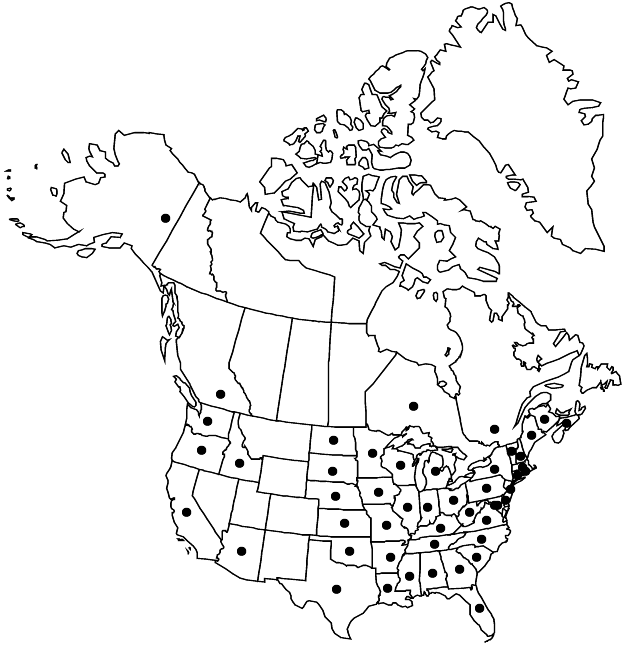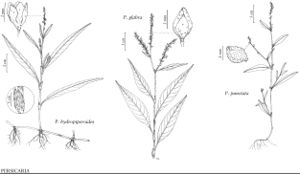Difference between revisions of "Persicaria hydropiperoides"
Fl. S.E. U.S., 378. 1903.
FNA>Volume Importer |
FNA>Volume Importer |
||
| Line 15: | Line 15: | ||
|name=Persicaria opelousana | |name=Persicaria opelousana | ||
|authority=(Riddell ex Small) Small | |authority=(Riddell ex Small) Small | ||
| − | }}{{Treatment/ID/Synonym | + | }} {{Treatment/ID/Synonym |
|name=Persicaria paludicola | |name=Persicaria paludicola | ||
|authority=Small | |authority=Small | ||
| − | }}{{Treatment/ID/Synonym | + | }} {{Treatment/ID/Synonym |
|name=Polygonum hydropiperoides var. adenocalyx | |name=Polygonum hydropiperoides var. adenocalyx | ||
|authority=(Stanford) Gleason | |authority=(Stanford) Gleason | ||
| − | }}{{Treatment/ID/Synonym | + | }} {{Treatment/ID/Synonym |
|name=Polygonum hydropiperoides var. asperifolium | |name=Polygonum hydropiperoides var. asperifolium | ||
|authority=Stanford | |authority=Stanford | ||
| − | }}{{Treatment/ID/Synonym | + | }} {{Treatment/ID/Synonym |
|name=Polygonum hydropiperoides var. breviciliatum | |name=Polygonum hydropiperoides var. breviciliatum | ||
|authority=Fernald | |authority=Fernald | ||
| − | }}{{Treatment/ID/Synonym | + | }} {{Treatment/ID/Synonym |
|name=Polygonum hydropiperoides var. bushianum | |name=Polygonum hydropiperoides var. bushianum | ||
|authority=Stanford | |authority=Stanford | ||
| − | }}{{Treatment/ID/Synonym | + | }} {{Treatment/ID/Synonym |
|name=Polygonum hydropiperoides var. digitatum | |name=Polygonum hydropiperoides var. digitatum | ||
|authority=Fernald | |authority=Fernald | ||
| − | }}{{Treatment/ID/Synonym | + | }} {{Treatment/ID/Synonym |
|name=Polygonum hydropiperoides var. opelousanum | |name=Polygonum hydropiperoides var. opelousanum | ||
|authority=(Riddell ex Small) W. Stone | |authority=(Riddell ex Small) W. Stone | ||
| − | }}{{Treatment/ID/Synonym | + | }} {{Treatment/ID/Synonym |
|name=Polygonum hydropiperoides var. psilostachyum | |name=Polygonum hydropiperoides var. psilostachyum | ||
|authority=H. St. John | |authority=H. St. John | ||
| − | }}{{Treatment/ID/Synonym | + | }} {{Treatment/ID/Synonym |
|name=Polygonum opelousanum | |name=Polygonum opelousanum | ||
|authority=unknown | |authority=unknown | ||
| − | }}{{Treatment/ID/Synonym | + | }} {{Treatment/ID/Synonym |
|name=Polygonum opelousanum var. adenocalyx | |name=Polygonum opelousanum var. adenocalyx | ||
|authority=Stanford | |authority=Stanford | ||
| Line 60: | Line 60: | ||
|elevation=0-1500 m | |elevation=0-1500 m | ||
|distribution=B.C.;N.B.;N.S.;Ont.;Que.;Ala.;Alaska;Ariz.;Ark.;Calif.;Conn.;Del.;D.C.;Fla.;Ga.;Idaho;Ill.;Ind.;Iowa;Kans.;Ky.;La.;Maine;Md.;Mass.;Mich.;Minn.;Miss.;Mo.;Nebr.;N.H.;N.J.;N.Y.;N.C.;N.Dak.;Ohio;Okla.;Oreg.;Pa.;R.I.;S.C.;S.Dak.;Tenn.;Tex.;Vt.;Va.;Wash.;W.Va.;Wis.;Mexico;Central America;South America. | |distribution=B.C.;N.B.;N.S.;Ont.;Que.;Ala.;Alaska;Ariz.;Ark.;Calif.;Conn.;Del.;D.C.;Fla.;Ga.;Idaho;Ill.;Ind.;Iowa;Kans.;Ky.;La.;Maine;Md.;Mass.;Mich.;Minn.;Miss.;Mo.;Nebr.;N.H.;N.J.;N.Y.;N.C.;N.Dak.;Ohio;Okla.;Oreg.;Pa.;R.I.;S.C.;S.Dak.;Tenn.;Tex.;Vt.;Va.;Wash.;W.Va.;Wis.;Mexico;Central America;South America. | ||
| − | |discussion=<p>The extreme variability in Persicaria hydropiperoides is reflected in its extensive synonymy. Among the segregates most often recognized in floras and checklists is P. opelousana, which C. B. McDonald (1980) showed to be broadly sympatric and highly interfertile with P. hydropiperoides. Consistent with this conclusion, R. S. Mitchell (1971) found that P. hydropiperoides and P. opelousana are unique among native North American smartweeds in consistently possessing multicellular plate-glands on the abaxial surface of their leaves. Such glands also are found on P. maculosa, an introduced European species.</p><!-- | + | |discussion=<p>The extreme variability in <i>Persicaria hydropiperoides</i> is reflected in its extensive synonymy. Among the segregates most often recognized in floras and checklists is P. opelousana, which C. B. McDonald (1980) showed to be broadly sympatric and highly interfertile with <i>P. hydropiperoides</i>. Consistent with this conclusion, R. S. Mitchell (1971) found that <i>P. hydropiperoides</i> and P. opelousana are unique among native North American smartweeds in consistently possessing multicellular plate-glands on the abaxial surface of their leaves. Such glands also are found on <i>P. maculosa</i>, an introduced European species.</p><!-- |
| − | --><p>Herbarium specimens of Persicaria hydropiperoides sometimes are misidentified as P. maculosa, especially when the roots are missing. The former species may be distinguished reliably by its achenes all trigonous (trigonous and biconvex achenes are mixed in the inflorescences of P. maculosa) and bristles on the margins of the ocreae that average longer. M. L. Fernald (1922c) reported hybrids with P. robustior from Nova Scotia.</p> | + | --><p>Herbarium specimens of <i>Persicaria hydropiperoides</i> sometimes are misidentified as <i>P. maculosa</i>, especially when the roots are missing. The former species may be distinguished reliably by its achenes all trigonous (trigonous and biconvex achenes are mixed in the inflorescences of <i>P. maculosa</i>) and bristles on the margins of the ocreae that average longer. M. L. Fernald (1922c) reported hybrids with <i>P. robustior</i> from Nova Scotia.</p> |
|tables= | |tables= | ||
|references= | |references= | ||
| Line 85: | Line 85: | ||
|publication year=1903 | |publication year=1903 | ||
|special status= | |special status= | ||
| − | |source xml=https://jpend@bitbucket.org/aafc-mbb/fna-data-curation.git/src/ | + | |source xml=https://jpend@bitbucket.org/aafc-mbb/fna-data-curation.git/src/8f726806613d60c220dc4493de13607dd3150896/coarse_grained_fna_xml/V5/V5_1195.xml |
|subfamily=Polygonaceae subfam. Polygonoideae | |subfamily=Polygonaceae subfam. Polygonoideae | ||
|genus=Persicaria | |genus=Persicaria | ||
Revision as of 17:36, 18 September 2019
Plants perennial, 1.5–10 dm; roots also often arising from proximal nodes; rhizomes often present. Stems decumbent to ascending, usually branched, without noticeable ribs, glabrous or obscurely strigose distally. Leaves: ocrea brown, cylindric, 5–23 mm, chartaceous, base inflated, margins truncate, ciliate with bristles (2–)4–10 mm, surface glabrous or strigose, not glandular-punctate; petiole 0.2–2 cm, glabrous or strigose; blade without dark triangular or lunate blotch adaxially, broadly lanceolate to linear-lanceolate, 5–25 × 0.4–3.7 cm, base tapered or acute, margins antrorsely appressed-pubescent, apex acuminate, faces glabrous or appressed-pubescent along midveins and sometimes on faces, usually punctate abaxially. Inflorescences terminal, sometimes also axillary, erect, uninterrupted or interrupted proximally, 30–80 × 2–5 mm; peduncle 10–30 mm, glabrous or strigose; ocreolae overlapping distally, often not overlapping proximally, margins ciliate with bristles to 2(–3) mm. Pedicels ascending, 1–1.5 mm. Flowers bisexual or unisexual and staminate, 2–6 per ocreate fascicle, homostylous; perianth roseate proximally, roseate, white, or greenish white distally, not glandular-punctate or sometimes glandular-punctate with punctae on tubes and inner tepals, scarcely accrescent; tepals 5, connate ca. 1/3–1/2 their length, obovate, 2.5–4 mm in bisexual flowers, 1.5–2.5 mm in staminate flowers, veins prominent or not, not anchor-shaped, margins entire, apex obtuse to rounded; stamens 8, included or exserted in staminate flowers; anthers pink or red, elliptic to ovate; styles 3, connate near middle. Achenes included or apex exserted, brown to brownish black or black, 3-gonous, 1.5–3 × 1–2.3 mm, shiny, smooth.
Phenology: Flowering Jun–Nov.
Habitat: Wet banks and clearings, shallow water, marshes, moist prairies, ditches
Elevation: 0-1500 m
Distribution

B.C., N.B., N.S., Ont., Que., Ala., Alaska, Ariz., Ark., Calif., Conn., Del., D.C., Fla., Ga., Idaho, Ill., Ind., Iowa, Kans., Ky., La., Maine, Md., Mass., Mich., Minn., Miss., Mo., Nebr., N.H., N.J., N.Y., N.C., N.Dak., Ohio, Okla., Oreg., Pa., R.I., S.C., S.Dak., Tenn., Tex., Vt., Va., Wash., W.Va., Wis., Mexico, Central America, South America.
Discussion
The extreme variability in Persicaria hydropiperoides is reflected in its extensive synonymy. Among the segregates most often recognized in floras and checklists is P. opelousana, which C. B. McDonald (1980) showed to be broadly sympatric and highly interfertile with P. hydropiperoides. Consistent with this conclusion, R. S. Mitchell (1971) found that P. hydropiperoides and P. opelousana are unique among native North American smartweeds in consistently possessing multicellular plate-glands on the abaxial surface of their leaves. Such glands also are found on P. maculosa, an introduced European species.
Herbarium specimens of Persicaria hydropiperoides sometimes are misidentified as P. maculosa, especially when the roots are missing. The former species may be distinguished reliably by its achenes all trigonous (trigonous and biconvex achenes are mixed in the inflorescences of P. maculosa) and bristles on the margins of the ocreae that average longer. M. L. Fernald (1922c) reported hybrids with P. robustior from Nova Scotia.
Selected References
None.
